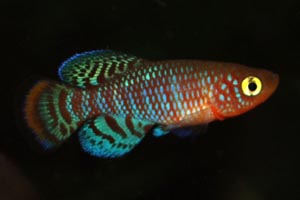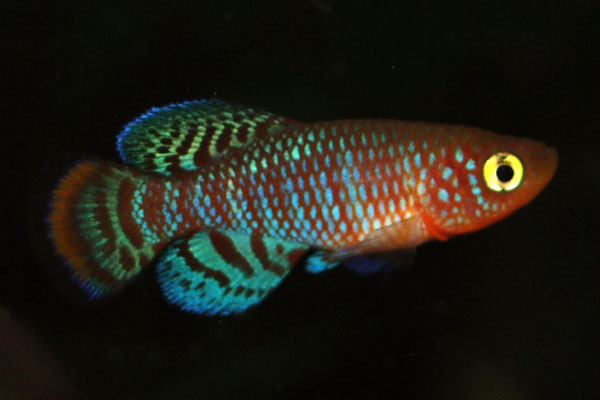

Species Profile | Images | Breeding Report | Similar Species

(Other members of the genus Nothobranchius)
ADULT SIZE: 7 cm
WATER CONDITIONS: Not critical
TEMPERATURE RANGE: 23-28 C
FOOD: Feed Nothobranchius rachovii predominantly live foods
DISTRIBUTION: This species comes from South Africa, Mozambique
SEXUAL DIFFERENCES: Female Nothobranchius are noticeably smaller than males, and lack the colouration that these fish are famous for.
AQUARIUM CARE: This small Southern African killifish vies for the position of most attractive fresh water species. This species is a real treat to keep but not for beginners. It requires regular livefoods, and being aggressive should be kept as a pair, trio or bigger group with many individuals. These are true annual fish, reaching maturity very quickly, yet rarely living longer than a year.
Nothobranchius are completely unsuitable for the community aquarium, and due to their short life span are best kept in a permanent breeding set up with a peat spawning substrate and no other species present.
BREEDING: This is a typical substrate spawner, eggs should be incubated in partially dried peat for up to six months, often less for newly collected species. The key is to collect many eggs, so whenever the eggs are rewetted, some fry will emerge.
Have you bred Nothobranchius rachovii? Why not fill in a breeding questionaire?, or examine existing Nothobranchius rachovii breeding reports
Other members of the genus Nothobranchius
Other killifish species
Other species from South Africa, Mozambique

Nothobranchius rachovii is one of the most spectacular of all aquarium species, and photographs rarely do it justice
BREEDING: This is a typical substrate spawner, eggs should be incubated in partially dried peat for up to six months, often less for newly collected species. The key is to collect many eggs, so whenever the eggs are rewetted, some fry will emerge.
Have you bred Nothobranchius rachovii? Why not fill in a breeding questionaire?
This page summarises breeding reports provided by visitors to this site, along with some statistical analysis. Please feel free to contribute - whatever your experience!
| |||||||||
|
| ||||||||
|
| ||||||||
| |||||||||
|
| ||||||||
Remember, each record represents only one persons experience; if you had different results, or used different methods, please share your experiences
| Water conditions: Moderately hard and alkaline | Water temperature: 24-27oC |
| Disposition: Somewhat aggresive on occasions | Community tank?: Doubtful, only with VERY calm fish |
| Spawning Method: Peat (or similar) spawning substrate | Breeding problems: none |
| Sex ratio: Somewhat male heavy | Breeding difficulty: Difficult |
| Sucess: Fairly sucessful | Years Experience: 10 |
| Other Comments: Fry are quick growing, but if underfed will eat each other. When one individual rapidly outgrows the rest, best to separate it. | |
| Date this record created: 6th January 2008 | Breeding date: 2006 |
| Breeder: | Location: |